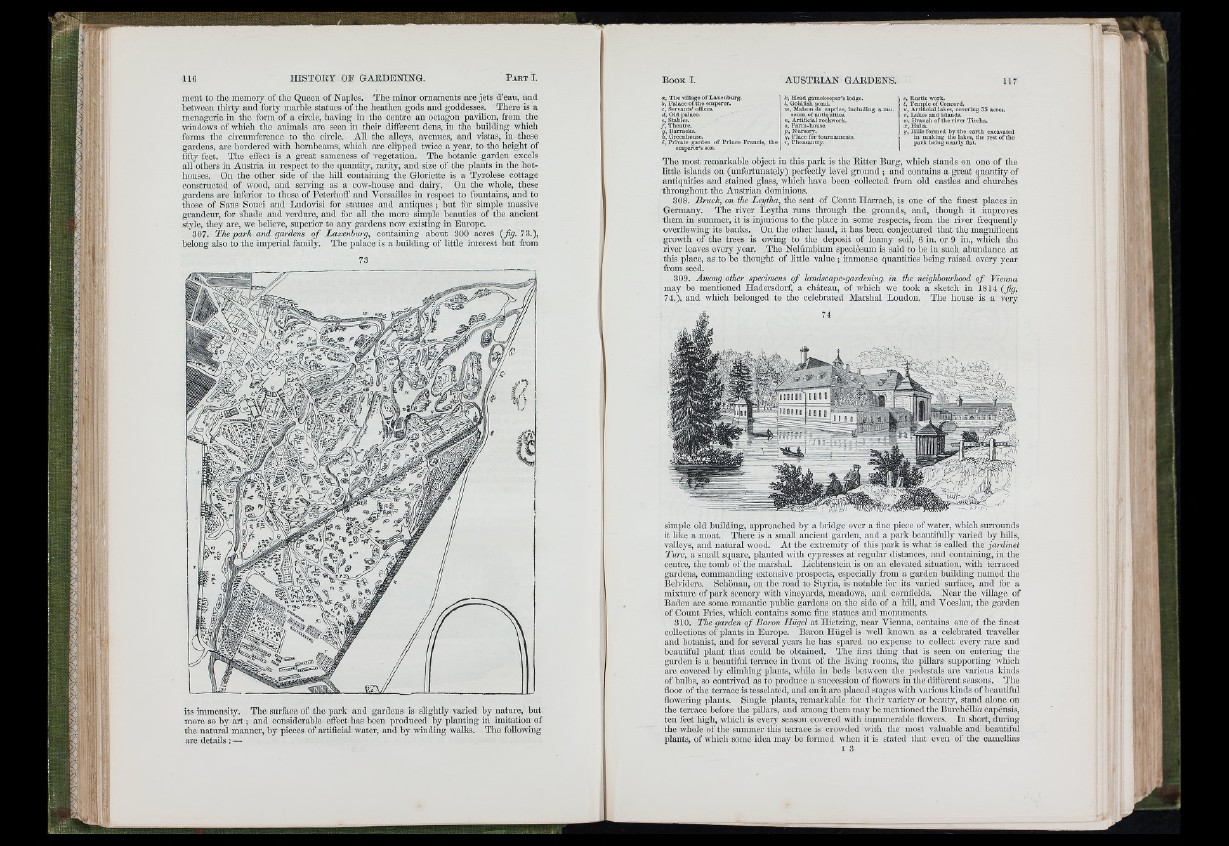
r5,
ß . i f
î ' ; r
p i '■
¥ l
r '
h
mcnt to the memoiy of the Queen of Naples. The minor ornaments are jets d’eau, and
betAveen thirty and forty marble statues of the heathen gods and goddesses. There is a
menagerie in the fonn of a circle, having in the centre an octagon pavilion, from the
AvindoAvs of Avhich the animals are seen in their different dens, in the building which
forms the circumference to the circle. All the alleys, avenues, and vistas, in these
gardens, ai-e bordered Avith hornbeams, Avhich are clipped tAvice a year, to the height of
fifty feet. The effect is a great sameness of vegetation. The botanic garden excels
all others in Austi-ia in respect to the quantity, raiity, and size of the plants in the hothouses.
On the other side of the hill containing the Gloriette is a Tyi'olese cottage
constructed of Avood, and serving as a coAv-house and daily. On the whole, these
gardens are infcrio-r to those of Petcrhoff aud Versailles in respect to fountains, and to
tliose of Sans Souci and Ludovisi for statues and an tiq u es; but for simple massiA^e
grandeur, for shade and A’erdure, and for all the more simple beauties of the ancient
style, they are, we believe, superior to any gardens u o a v existing in Eui-ope.
307. The park and gardens o f Laxenburg, containing about 300 acres ( fg . 73.),
belong also to the imperial family. The palace is a building of little interest but from
its immensity. The surface of the park and gardens is slightly varied by nature, but
more so by art ; and considerable effect has been produced by planting in imitation of
the natural manner, by pieces of ai*tificial Avater, and by Avinding walks. The foUoAving
are details: —
c. Servants’ ofBcos.
d. Old palace.
e. Stables.
/ , Theatre.
f,0, Farm-house,
p . Nursery.
<7, Place for tournaioents.
r , Pheasantry.
s, Rustic work.
I, Temple of Concord.
1C, Artificial lakes, covering 33 acre*.
Lakes an d islands.
IV, Branch of th e riv er Tircha.
X, Haha.
y, HUls formed by th e e arth exeavated
in mak in g tho lakes, th e rest of the
p a rk being nearly flat.
a, Barracks.
Greenhouse,
f, Priv a te garden of Prince Francis, the
emperor’s son.
The most remarkable object in this park is the Ritter Bm-g, which stands on one of the
little islands on (unfortunately) perfectly level ground ; and contains a great quantity of
antiquities and stained glass, which have been collected from old castles and churches
throughout the Austrian dominions.
308. Bruck, on the Leytha, the seat of Count Harrach, is one of the finest places in
Germany. The river Leytlia runs through the grounds, and, though it improves
them ill summer, it is injurious to the place in some respects, from the river frequently
overflowing its banks. On the other hand, it has heen conjectured that the magnificent
groAvth of the trees is owing to the deposit of loamy soil, 6 in. or 9 in., Avhich tlie
river leaves every year. . The Nclumbium speciosum is said to be in such abundance at
tliis place, as to be thought of Httle value ; immense quantities being raised every yeai’
from seed.
309. Among other specimens o f landscape-gardening in the neighbourhood o f Vienna
may bo mentioned Hadersdorf, a château, of which we took a sketch in 1814 ( fg .
74.), and which belonged to the celebrated Marshal Loudon. The house is a very
simple old building, approached by a bridge over a fine piece of Avater, Avhich suiTounds
it like a moat. There is a small ancient garden, and a park beautifully vaiied by hüls,
valleys, and natural Avood. At the extremity of this pai-k is Avhat is called the jardinet
Turc, a small square, planted Avith cjqiresses at regular distances, and containing, in the
centre, the tomb of the niarshul. Lichtenstein is on an elevated situation, with tcn-aced
gai’dens, commanding extensive prospects, especially Irom a garden building named the
Belvidcre. Schönau, on the road to Styi-ia, is notable ior its varied sm-face, and for a
mixture of park sceneiy Avith vineyards, meadoAvs, and cornfields. Near the village of
Baden are some romantic public gardens on the side of a liill, and Voeslau, the garden
of Count Fries, Avhich contains some fine statues and monmnents.
310. The garden o f Baron Hügel at Hietzing, neai- Vienna, contains one of the finest
collections of plants iu Europe. Baron Hügel is Avell knoAvn as a celebrated traveller
and botanist, and for several yeai’s he has spai-ed no expense to collect evciy rare and
beautiful plant that could be obtained. The first thing that is seen on entering the
garden is a beautiful teiTace in fr’ont of the living rooms, the pillars supporting Avliich
iu*e covered by climbing plants, while iu beds betAvcen the pedestals are vaiious kinds
of bulbs, so contrived as to produce a succession of floAvcrs in the different seasons. Tlie
floor of the terrace is tesselated, and on it are placed stages with various kinds of beautiful
flowering plants. Single plauts, remai’kable for their variety or beauty, stand alone ou
tlie tciTacc before the pillars, and among them may be mentioned the Bnrchell/a capensis,
ten feet high, which is every season covered with innumerable floAvers. In short, during
the whole of the summer tliis terrace is croAvded Avitli tlic most valuable and beautifui
plauts, of which some idea may be formed Avhen it is stated that cA'cn of the camellias
I 3